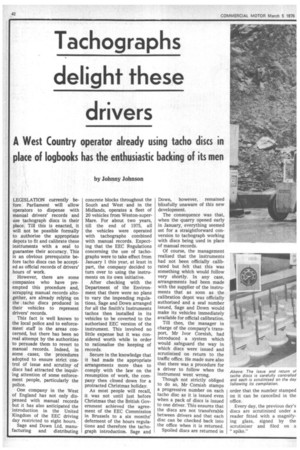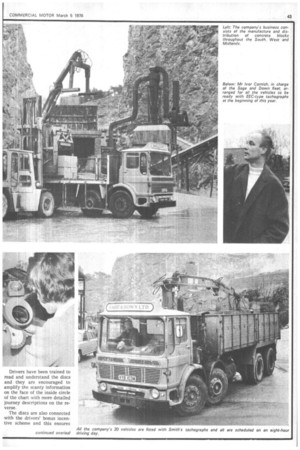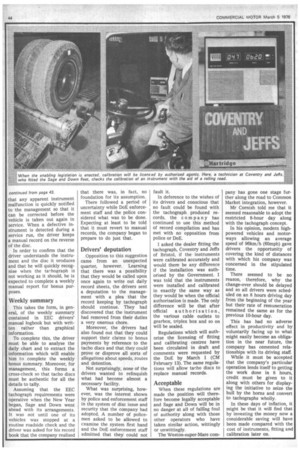Tachographs
Page 44

Page 45

Page 46

If you've noticed an error in this article please click here to report it so we can fix it.
delight these
drivers A West Country operator already using tacho discs in
place of logbooks has the enthusiastic backing of its men
by Johnny Johnson
LEGISLATION currently before Parliament will allow operators to dispense with manual drivers' records and use tachograph discs in their place. Till this is enacted, it will not be possible formally to authorise the appropriate depots to fit and calibrate these instruments with a seal to guarantee their accuracy. This is an obvious prerequisite before tacho discs can be accepted as official records of drivers' hours of work.
However, there are some companies who have preempted this procedure and, scrapping manual records altogether, are already relying on the tacho discs produced in their vehicles to represent drivers' records.
This fact is well known to the local police and to enforcement staff in the areas concerned, but there has been no real attempt by the authorities to persuade them to revert to manual records. Indeed, in some cases, the procedures adopted to ensure strict control of issue and scrutiny of discs had attracted the inquiring attention of some enforcement people, particularly the police.
One company in the West of England has not only dispensed with manual records but it has also anticipated the introduction in the United Kingdom of the EEC driving day restricted to eight hours.
Sage and Down Ltd, manufacturing and distributing concrete blocks throughout the South and West and in the Midlands, operates a fleet of 20 vehicles from Weston-superMare. For about two years, till the end of 1975, all the vehicles were operated with tachographs combined with manual records. Expecting that the EEC Regulations concerning the use of tachographs were to take effect from January 1 this year, at least in part, the company decided to turn over to using the instruments on its own initiative.
After checking with the Department of the Environment that there were no plans to vary the impending regulations, Sage and Down arranged for all the Smith's Instruments tachos then installed in its vehicles to be coverted to the authorised EEC version of the instrument. This involved no little expense but it was considered worth while in order to rationalise the keeping of records.
Secure in the knowledge that it had made the appropriate arrangements more than to comply with the law on the resumption of work, the company then closed down for a protracted Christmas holiday.
As most people will recall, it was not until just before Christmas that the British Government achieved the agreement of the EEC Commission in Brussels to a six months' deferment of the hours regulations and therefore the tachograph introduction. Sage and Down, however, remained blissfully unaware of this new development.
The consequence was that, when the quarry opened early in January, everything seemed set for a straightforward conversion to tachograph working with discs being used in place of manual records.
Of course, the management realised that the instruments had not been officially calibrated but felt that this was something which would follow very shortly. In any case, arrangements had been made with the supplier of the instruments that as soon as the calibration depot was officially authorised and a seal number issued, Sage and Down would make its vehicles immediately available for official calibration.
Till then, the manager in charge of the company's transport, Mr Ivor Cornish, had introduced a system which would safeguard the way in which discs were issued and scrutinised on return to the traffic office. He made sure also that there was a procedure for a driver to follow when the instrument went wrong.
Though not strictly obliged to do so, Mr Cornish stamps a progressive number on each tacho disc as it is issued even when a pack of discs is issued to one driver. This ensures that the discs are not transferable between drivers and that each disc can be checked back into the office when it is returned.
Spoiled discs are returned in order that the number stamped on it can be cancelled in the office.
Every day, the previous day's discs are scrutinised under a reader fitted with a magnifying glass, signed by the scrutiniser and filed on a " spike." Drivers have been trained to read and understand the discs and they are encouraged to amplify the scanty information on the face of the inside circle of the chart with more detailed journey descriptions on the reverse.
The discs are also connected with the drivers' bonus incentive scheme and this ensures
continued from page 43.
that any apparent instrument malfunction is quickly notified to the management so that it can be corrected before the vehicle is taken out again in service. When a defective instrument is detected during a service run, the driver keeps a manual record on the reverse of the disc.
In order to confirm that the driver understands the instrument and the disc it produces and that he will quickly recognise when the tar..hograph is not working as it should, he is expected to complete a weekly manual report for bonus purposes.
Weekly summary
This takes the form, in general, of the weekly summary contained in EEC drivers' manual logbook but with written rather than graphical information.
To complete this, the driver must be able to analyse the daily chart and to extract the information which will enable him to complete the weekly bonus summary. Moreover, for management, this forms a cross-check so that tacho discs must be authentic for all the details to tally.
Assuming that the EEC tachograph requirements were operative when the New Year began, Sage and Down went ahead with its arrangements. it was not until one of its vehicles was stopped at a routine roadside check and the driver was asked for his record book that the company realised that there was, in fact, no foundation for its assumption.
There followed a period of uncertainty while DoE enforcement staff and the police considered what was to be done. Expecting at least to be told that it must revert to manual records, the company began to prepare to do just that.
Drivers' deputation
Opposition to this suggestion came from an unexpected quarter, however. Learning that there was a possibility that they would be called upon once again to write out daily record sheets, the drivers sent a deputation to the management with a plea that the record keeping by tachograph should continue. They had discovered that the instrument had removed from their duties a very onerous chore.
Moreover, the drivers had also found out that they could support their claims to bonus payments by reference to the tacho discs and that they could prove or disprove all sorts of allegations about speeds, routes and detention.
Not surprisingly, none of the drivers wanted to relinquish what had become almost a necessary facility.
What was surprising, however, was the interest shown by police and enforcement staff in the system of disc issue and security that the company had adopted. A number of policemen asked to be allowed to examine the system first hand and the DoE enforcement staff admitted that they could not fault it.
In deference to the wishes of its drivers and conscious that no fault could be found with the tachograph produced records, the company has continued to use this method of record compilation and has met with no opposition from police or DoE.
I asked the dealer fitting the tachograph, Coventry and Jeffs of Bristol, if the instruments were calibrated accurately and would there be any difference if the installation was authorised by the Government. I was told that the instruments were installed and calibrated in exactly the same way as they would be when the official authorisation is made. The only difference will be that after official authorisation, the various cable outlets to gearbox, triplex box and so on will be sealed.
Regulations which will authorise the licensing of fitting and calibrating centres have been circulated in draft and comments were requested by the DoE by March 1 (CM February 13). The same regulations will allow tarho discs to replace manual records.
Acceptable
When these regulations are made the position will therefore become legally acceptable and Sage and Down will be in no danger at all of falling foul of authority along with those other operators who have taken similar action, wittingly or unwittingly.
The Weston-super-Mare corn pany has gone one stage further along the road to Common Market integration, however.
Mr Cornish told me that it seemed reasonable to adopt the restricted 8-hour day along with the tachograph concept.
In his opinion, modern highpowered vehicles and motorways allowing an average speed of 96km/h (60mph) gave drivers the opportunity of covering the kind of distances with which his company was concerned in the stipulated time.
There seemed to be no reason, therefore, why the change-over should be delayed and so all drivers were scheduled on an 8 hours driving day from the beginning of the year but their rate of remuneration remained the same as for the previous 10-hour day.
This has had no adverse effect in productivity and by voluntarily facing up to what might easily become an obligation in the near future, the company has cemented rela tionships with its driving staff. While it must be accepted that the company's particular operation lends itself to getting the work done in 8 hours, credit must be given to it along with others for displaying the initiative to seize the bull by the horns and convert to tachographs wholly.
In these days of inflation, it might be that it will find that by investing the money now a considerable saving will have been made compared with the cost of instruments, fitting and calibration later on.




















































































































































